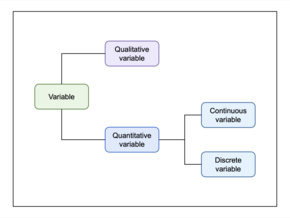
Back Variable discreta y variable continua Spanish متغیر پیوسته یا گسسته Persian Variable discrète French 连续变量与离散变量 Chinese 連續同離散變數 ZH-YUE
| Part of a series on statistics |
| Probability theory |
|---|
 |
It has been suggested that this article be merged with Statistical data type. (Discuss) Proposed since November 2024. |
In mathematics and statistics, a quantitative variable may be continuous or discrete if they are typically obtained by measuring or counting, respectively.[1] If it can take on two particular real values such that it can also take on all real values between them (including values that are arbitrarily or infinitesimally close together), the variable is continuous in that interval.[2] If it can take on a value such that there is a non-infinitesimal gap on each side of it containing no values that the variable can take on, then it is discrete around that value.[3] In some contexts, a variable can be discrete in some ranges of the number line and continuous in others.

- ^ Ali, Zulfiqar; Bhaskar, S. Bala (September 2016). "Basic statistical tools in research and data analysis". Indian Journal of Anaesthesia. 60 (9): 662–669. doi:10.4103/0019-5049.190623. PMC 5037948. PMID 27729694.
- ^ Kaliyadan, Feroze; Kulkarni, Vinay (January 2019). "Types of Variables, Descriptive Statistics, and Sample Size". Indian Dermatology Online Journal. 10 (1): 82–86. doi:10.4103/idoj.IDOJ_468_18. PMC 6362742. PMID 30775310.
- ^ K.D. Joshi, Foundations of Discrete Mathematics, 1989, New Age International Limited, [1], page 7.